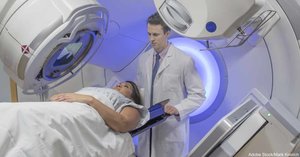Many breast cancer patients use radiation treatment to help kill any remaining cancer cells and keep them from returning. But a traditional whole-breast radiation treatment takes at least three or four weeks and often as much as six weeks. It can also cause some painful side effects, such as fatigue, rash, dry or peeling skin, nerve damage, or swollen lymph nodes.Now, however, the results of a long-term study comparing whole-breast radiation and accelerated partial-breast radiation (APBI) have revealed that the latter option is not only faster and less invasive, but it may be just as effective as whole-breast radiation.The study investigated 10-year recurrence rates for 520 breast cancer patients who underwent either whole-breast or accelerated partial-breast radiation therapy as part of their treatment. The participants were all women over 40, and most were over 50. All had stage I or II breast cancer, most often hormone-receptor-positive and HER-2 negative. Photo: Adobe Stock/Photographee.eu
Photo: Adobe Stock/Photographee.eu
Those who did the partial-breast radiation, which only takes 10 days instead of several weeks, were not found to have a higher rate of cancer recurrence five years after their treatment. After ten years, their recurrence rate was 3.3 percent, compared to 2.6 percent of whole-breast radiation patients, a difference that researchers say is not statistically significant.Survival rates between the two methods of radiation were also similar, at 97.6 percent for partial-breast radiation and 97.5 percent for whole-breast radiation.“APBI is a safe and less invasive treatment as compared to whole breast irradiation,” said the study’s lead author, Dr. Icro Meattini, an associate professor at the University of Florence in Italy. “It is cost-effective and the overall treatment time is diminished.”
 Photo: Adobe Stock/Mark KostichPartial-breast radiation focuses on just the area of the breast where the cancer was found, diminishing the side effects of the treatment. Receiving a higher dose for a shorter amount of time can also reduce side effects (as doctors and patients both agreed) and help patients cope with treatment. While it is important to analyze the treatment options on a case-by-case basis, Meattini believes partial-breast radiation should be an option offered to many breast cancer patients.This is great news for the cancer field, as it may mean an extra option for women with early-stage breast cancer. The concept may also be applicable to radiation treatment for other types of cancers in the future.“This study showed that the 10-year rates of recurrence were similar to the five-year rates, and adds to the growing body of research that suggests more is not always better,” says Dr. Stephanie Bernik, chief of breast service at Mount Sinai West in New York City, who was not involved in the study.
Photo: Adobe Stock/Mark KostichPartial-breast radiation focuses on just the area of the breast where the cancer was found, diminishing the side effects of the treatment. Receiving a higher dose for a shorter amount of time can also reduce side effects (as doctors and patients both agreed) and help patients cope with treatment. While it is important to analyze the treatment options on a case-by-case basis, Meattini believes partial-breast radiation should be an option offered to many breast cancer patients.This is great news for the cancer field, as it may mean an extra option for women with early-stage breast cancer. The concept may also be applicable to radiation treatment for other types of cancers in the future.“This study showed that the 10-year rates of recurrence were similar to the five-year rates, and adds to the growing body of research that suggests more is not always better,” says Dr. Stephanie Bernik, chief of breast service at Mount Sinai West in New York City, who was not involved in the study.
 Photo: Adobe Stock/Evgeniy KalinovskiyBernik also says that having partial-breast radiation as a standard treatment option will allow women to get back to work faster and will allow women who do not have easy access to a radiation center to choose radiation treatment too. “Many women do not live close to a treatment center, but might now consider spending a week away from home compared to over a month,” she says.Which type of radiation would you prefer and why? Larger studies on this topic are needed to demonstrate APBI’s effectiveness, but faster treatment and fewer side effects are certainly things to get excited about! Share on Facebook
Photo: Adobe Stock/Evgeniy KalinovskiyBernik also says that having partial-breast radiation as a standard treatment option will allow women to get back to work faster and will allow women who do not have easy access to a radiation center to choose radiation treatment too. “Many women do not live close to a treatment center, but might now consider spending a week away from home compared to over a month,” she says.Which type of radiation would you prefer and why? Larger studies on this topic are needed to demonstrate APBI’s effectiveness, but faster treatment and fewer side effects are certainly things to get excited about! Share on Facebook
Source
Home World News Study Finds Accelerated Partial-Breast Radiation Just as Effective as Whole Breast Radiation






